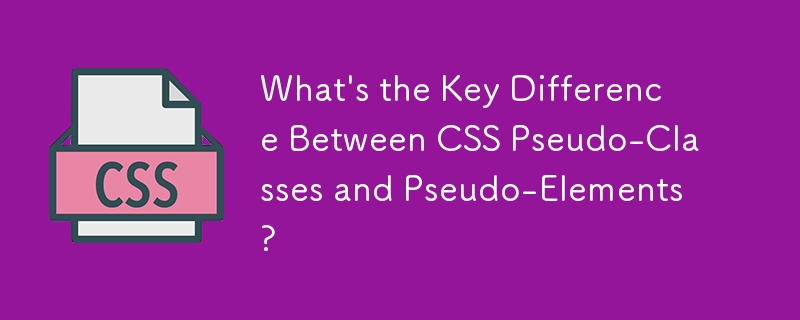 Web Front-end
Web Front-end
 CSS Tutorial
CSS Tutorial
 What's the Key Difference Between CSS Pseudo-Classes and Pseudo-Elements?
What's the Key Difference Between CSS Pseudo-Classes and Pseudo-Elements?
What's the Key Difference Between CSS Pseudo-Classes and Pseudo-Elements?

Distinguishing Pseudo-Classes from Pseudo-Elements in CSS
In CSS, pseudo-classes and pseudo-elements play distinct roles in refining the selection of HTML elements. Understanding their differences is crucial for effectively styling web pages.
Pseudo-Classes
As defined in the CSS 3 selector recommendation, pseudo-classes allow element selection based on information not directly found in the document tree. This includes states like :active, :visited, :hover, or conditions like :nth-child. Pseudo-classes always consist of a colon (:) followed by a name.
Purpose: Pseudo-classes enable fine-tuning of selection based on dynamic properties not present in the DOM. They enhance selectors by targeting elements based on interaction states, structural position, or usage context.
Pseudo-Elements
Unlike pseudo-classes, pseudo-elements refer to content or concepts that do not physically exist in the source document. They enable access to information like the first letter (:first-letter), first line (:first-line), or generated content (:before, :after). Pseudo-elements are written using two colons (::) followed by a name.
Purpose: Pseudo-elements provide a way to manipulate and style content that is not explicitly defined in the HTML. They allow authors to add decorative elements, introduce accessible information, or create visual effects.
Key Differences:
- Selection Nature: Pseudo-classes refine element selection based on their properties, while pseudo-elements introduce new virtual elements for manipulation.
- Applicability: Only one pseudo-element per selector is allowed, unlike pseudo-classes that can be combined in a sequence.
- Scope: Pseudo-classes influence the selection of elements, while pseudo-elements create virtual elements with their own unique scope.
- Content Manipulation: Pseudo-elements can introduce new content or affect existing content, whereas pseudo-classes solely target existing elements.
Examples:
- Pseudo-class: a:hover { color: red; } changes the color of links when hovered.
- Pseudo-element: ::before { content: "Hello, "; } adds "Hello, " to the beginning of an element's text.
Conclusion:
Pseudo-classes and pseudo-elements are powerful tools in CSS that enhance the flexibility and accessibility of web pages. Comprehensively understanding their differences allows developers to effectively control the appearance and behavior of HTML elements, ultimately delivering rich and interactive user experiences.
The above is the detailed content of What's the Key Difference Between CSS Pseudo-Classes and Pseudo-Elements?. For more information, please follow other related articles on the PHP Chinese website!

Hot AI Tools

Undresser.AI Undress
AI-powered app for creating realistic nude photos

AI Clothes Remover
Online AI tool for removing clothes from photos.

Undress AI Tool
Undress images for free

Clothoff.io
AI clothes remover

AI Hentai Generator
Generate AI Hentai for free.

Hot Article

Hot Tools

Notepad++7.3.1
Easy-to-use and free code editor

SublimeText3 Chinese version
Chinese version, very easy to use

Zend Studio 13.0.1
Powerful PHP integrated development environment

Dreamweaver CS6
Visual web development tools

SublimeText3 Mac version
God-level code editing software (SublimeText3)

Hot Topics
 1379
1379
 52
52
 Working With GraphQL Caching
Mar 19, 2025 am 09:36 AM
Working With GraphQL Caching
Mar 19, 2025 am 09:36 AM
If you’ve recently started working with GraphQL, or reviewed its pros and cons, you’ve no doubt heard things like “GraphQL doesn’t support caching” or
 Building an Ethereum app using Redwood.js and Fauna
Mar 28, 2025 am 09:18 AM
Building an Ethereum app using Redwood.js and Fauna
Mar 28, 2025 am 09:18 AM
With the recent climb of Bitcoin’s price over 20k $USD, and to it recently breaking 30k, I thought it’s worth taking a deep dive back into creating Ethereum
 Creating Your Own Bragdoc With Eleventy
Mar 18, 2025 am 11:23 AM
Creating Your Own Bragdoc With Eleventy
Mar 18, 2025 am 11:23 AM
No matter what stage you’re at as a developer, the tasks we complete—whether big or small—make a huge impact in our personal and professional growth.
 Vue 3
Apr 02, 2025 pm 06:32 PM
Vue 3
Apr 02, 2025 pm 06:32 PM
It's out! Congrats to the Vue team for getting it done, I know it was a massive effort and a long time coming. All new docs, as well.
 Can you get valid CSS property values from the browser?
Apr 02, 2025 pm 06:17 PM
Can you get valid CSS property values from the browser?
Apr 02, 2025 pm 06:17 PM
I had someone write in with this very legit question. Lea just blogged about how you can get valid CSS properties themselves from the browser. That's like this.
 A bit on ci/cd
Apr 02, 2025 pm 06:21 PM
A bit on ci/cd
Apr 02, 2025 pm 06:21 PM
I'd say "website" fits better than "mobile app" but I like this framing from Max Lynch:
 Comparing Browsers for Responsive Design
Apr 02, 2025 pm 06:25 PM
Comparing Browsers for Responsive Design
Apr 02, 2025 pm 06:25 PM
There are a number of these desktop apps where the goal is showing your site at different dimensions all at the same time. So you can, for example, be writing
 Stacked Cards with Sticky Positioning and a Dash of Sass
Apr 03, 2025 am 10:30 AM
Stacked Cards with Sticky Positioning and a Dash of Sass
Apr 03, 2025 am 10:30 AM
The other day, I spotted this particularly lovely bit from Corey Ginnivan’s website where a collection of cards stack on top of one another as you scroll.



